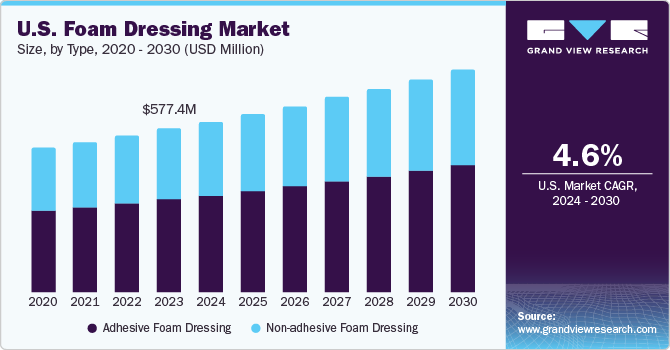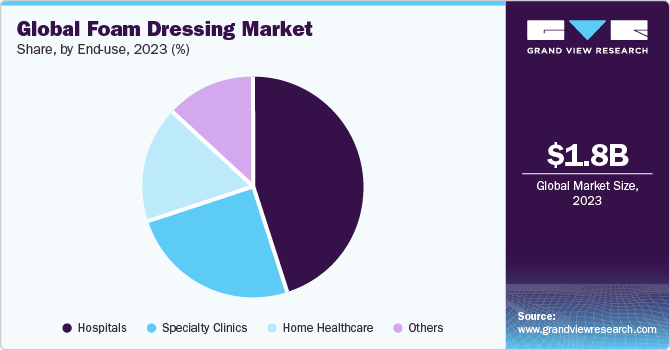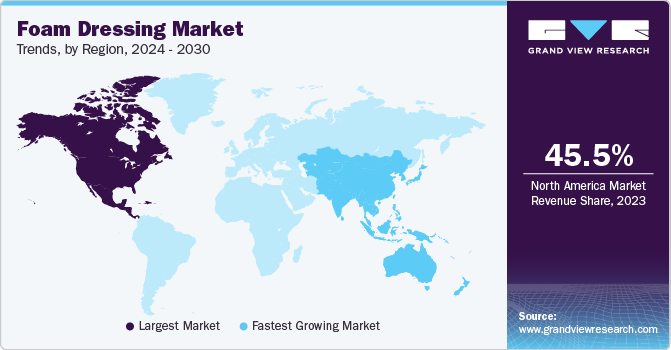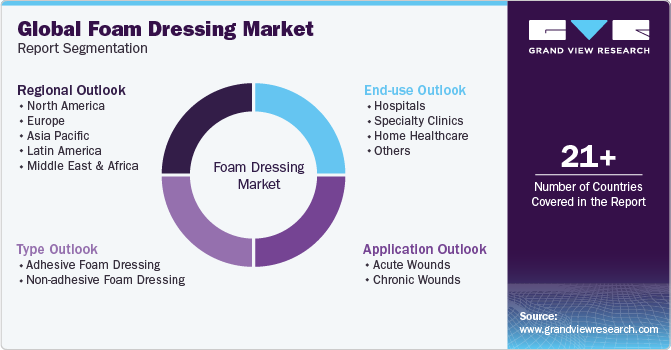
Foam Dressing Market Size, Share & Trends Analysis Report By Type (Adhesive Foam Dressing, Non-adhesive Foam Dressing), By Application (Chronic Wounds, Acute Wounds), By End-use, By Region, And Segment Forecasts, 2024 - 2030
- Report ID: GVR-4-68039-951-5
- Number of Report Pages: 120
- Format: PDF
- Historical Range: 2018 - 2023
- Forecast Period: 2024 - 2030
- Industry: Healthcare
Foam Dressing Market Size & Trends
The global foam dressing market size was valued at USD 1.82 billion in 2023 and is anticipated to grow at a CAGR of 4.73% from 2024 to 2030. The growing demand for foam dressing items can be attributed to a rise in burn incidents, diverse types of ulcers, open wounds, and a surge in global surgical procedures. In addition, diabetes is anticipated to be the main cause of these wounds. According to the International Diabetes Federation, in 2021, approximately 537 million adults between the ages of 20 and 79 are affected by diabetes, equating to 1 in 10 individuals. This number is estimated to rise to 643 million by 2030 and further to 783 million by 2045. Notably, over 75% of these adults with diabetes reside in low- and middle-income countries.

The increasing number of chronic wounds has had a profound impact on the market for foam dressing. Chronic wounds such as pressure ulcers, venous leg ulcers, and diabetic foot ulcers mainly affect a large portion of the population. According to Multidisciplinary Digital Publishing Institute (MDPI) study, January 2022, in countries with affluence, 1-2% of people suffer from chronic severe wounds. Over 6.0 million Americans are estimated to have experienced at least one chronic wound in their lives. According to the American Diabetes Association’s report of December 2022, untreated diabetes over an extended period can frequently result in diabetic foot ulcers (DFU), which are extremely dangerous. An approximately 19% to 34% of the estimated 537 million diabetics worldwide are expected to experience a DFU at some point in their lives, which highly contributes to the demand of foam dressings.
Similarly, the increasing number of road accidents & injuries are mainly attributed to the adoption of foam dressing. For instance, according to a World Health Organization report, June 2022, over one million individuals lose their lives in vehicle crashes each year. An estimated 20 to 50 million additional individuals sustain non-fatal injuries each year, many of which end in disability. Despite having over 60% of the world's vehicles, low- and middle-income countries account for over 90% of all road fatalities worldwide. In addition, approximately 1,200 people lost their lives in car crashes in 2022. This represents a 5.8% increase over 2021. National fatalities have essentially remained unchanged over the last decade. Millions of people still experience daily disruptions due to skin injuries across their bodies, which can lead to infection, extended hospital admissions, and even death.
The advancements in additive manufacturing have led to creative solutions in several healthcare sectors. Foam dressings represent a breakthrough in the treatment of wounds. Despite advances in understanding of the cellular and molecular mechanisms underlying wound healing, the management of chronic wounds is still a challenge. For instance, in January 2023, ConvaTec introduced ConvaFoam to the U.S. market, a line of innovative foam dressings tailored to cater to healthcare providers and their patients' requirements. Being versatile in addressing various wound types at any stage of the healing process, ConvaFoam emerges as a convenient option for wound management and skin protection.
Market Concentration & Characteristics
The degree of innovation in the foam dressing market is evident through products such as the silicone foam dressing offered by Winner Medical. This medical-grade product features a gentle polysilicone contact layer that is bonded to the backing's framework, providing unique properties that enhance its usability and patient comfort. The soft polysilicone contact layer allows for multiple applications without sticking to the wound, making it more convenient for medical professionals to change medications and prevent further injuries. In addition, this feature significantly reduces patient discomfort, which greatly contributes to improving the overall quality of life for patients. This innovation in foam dressing technology demonstrates a commitment to advancing wound care solutions, catering to the needs of both healthcare providers and patients alike.

The level of mergers and acquisitions (M&A) activity in the foam dressing industry indicates a moderate to high level of interest from companies seeking to expand their product portfolios, strengthen their market presence, or gain access to new technologies. As the demand for advanced wound care solutions grows, manufacturers and investors are keen to explore strategic partnerships and acquisitions to stay competitive in this dynamic market. For instance, in October 2023, Lion Street Medical, LLC, completed the acquisition of Pensar Medical, LLC, a medical device company with a strong focus on wound care. This strategic takeover has introduced new management to the esteemed Pensar Medical and WoundPro brands, further strengthening their presence in the medical industry.
Regulation in the foam dressing industry is significant for maintaining product safety, fostering fair competition, and promoting innovation. Governmental and regulatory bodies establish guidelines and standards for foam dressing manufacturing, testing, and marketing, which ensures patients receive high-quality and reliable products. These measures help create a level playing field for market participants, encourage innovation, and prevent market dominance by a few large companies. Regulatory approval is crucial for market access, and the process ensures that only safe and effective products are available for patients, building consumer trust. Companies must invest in research and development to meet evolving requirements, leading to innovative wound care solutions. Although compliance with these requirements can be costly, the overall impact of regulation is positive, benefiting patients, healthcare providers, and the industry.
Product expansion in the foam dressing industry can be considered moderate. While the market is growing due to increasing demand for advanced wound care solutions, it is not experiencing an extremely high rate of expansion. For in stance, in June 2022,Medline launched an upgraded version of its Optifoam Gentle EX Foam Dressing, designed to effectively combat pressure injuries. The Optifoam Gentle EX dressing plays a vital role in Medline's Skin Health Solution Program, a comprehensive strategy encompassing people, processes, and products to deliver optimal skin and wound care outcomes. Factors contributing to this moderate growth include the continuous development of new foam dressing products, the increasing prevalence of chronic wounds, and the aging global population. In addition, regulatory frameworks play a crucial role in ensuring product safety and quality, which may slightly slow down the expansion rate.
The regional expansion of the foam dressing industry can be characterized as moderate, with various regions exhibiting differing levels of growth. North America and Europe have traditionally been the major contributors to the market's expansion due to the presence of well-established healthcare systems and a growing demand for advanced wound care solutions. These regions are expected to maintain a moderate growth rate, driven by factors such as an aging population, increasing prevalence of chronic diseases, and rising healthcare expenditures.
End-use Insights
The hospital segment held the largest revenue share of 45.45% in 2023. Hospitals play a crucial role in providing comprehensive healthcare services, including wound care, to a large patient population. As hospitals expand and modernize their facilities and services, they increasingly incorporate advanced wound care technologies and products, such as foam dressings, into their offerings. For instance, as per the American Hospital Association study 2022, over 6,000 hospitals were anticipated in the U.S. in 2020, and more than 33,355,000 admissions were reported in all U.S. hospitals in 2020.
According to the National Center of Biotechnology Information (NCBI) study published in 0ctober 2020, it is estimated that over 2.0 million hospital admissions in the U.S. are attributed to pressure ulcers. In addition, the U.S. healthcare system spends over USD 10 billion annually on treating and preventing pressure ulcers. In the UK, treating pressure ulcers accounts for 4% of overall treatment expenses.

The home healthcare segment is anticipated to witness the fastest CAGR over the forecast period, which can be attributed to factors such as the increasing global aging population, convenience of receiving medical care in a familiar environment, and adoption of advanced wound care technologies. Home healthcare services provide patients with better access to wound management, which is cost-effective and promotes preventive care. The availability of user-friendly foam dressings and technological advancements in this field have also made it easier for home healthcare professionals to incorporate these products into their treatment plans, further driving the growth of this segment.
Type Insights
The adhesive foam dressing segment dominated the market in 2023 with the largest revenue share of 56.59%. In addition, the segment is expected to register the fastest CAGR of 4.78 over the forecast period. Adhesive foam dressings offer a high level of patient comfort, as they are designed to adhere securely to the skin while allowing for breathability and flexibility. This is particularly important for patients with sensitive skin or requiring long-term wound care, as it minimizes discomfort and promotes a conducive healing environment. Moreover, advancements in technology have led to the development of specialized adhesive foam dressings that cater to specific wound types and patient needs. This has expanded the market's appeal, as healthcare professionals can now choose from a wide range of products tailored to address various wound care challenges. For instance, hydrocolloid technology is known for its ability to create a moist wound healing environment by absorbing exudate and forming a secondary skin-like layer over the wound. This helps protect the wound from external contaminants and maintains a suitable environment for healing. By incorporating this technology into adhesive foam dressings, manufacturers have created a product that offers the best of both worlds - the security and comfort of adhesive foam dressings, combined with the moist wound healing benefits of hydrocolloids.
The non-adhesive foam dressing segment is expected to register a considerable CAGR over the forecast period. The growth of non-adhesive foam dressing can be linked to the increasing popularity of alternative wound care treatments, such as negative pressure wound therapy (NPWT) and hydrogels. These alternative treatments cater to specific wound care needs and may require the use of non-adhesive foam dressings as part of the treatment regimen.
Application Insights
The chronic wounds segment held the largest revenue share of 59.83% in 2023. The rise in the number of geriatric population and the increasing prevalence of venous leg ulcers, diabetic foot ulcers, pressure ulcers, and other chronic wounds are expected to drive the segment growth. For instance, according to the InDependent Diabetes Trust, 115,000 people in the UK may experience a diabetic foot ulcer at any point in their lives. In comparison, over 275,000 people receive treatment for venous leg ulcers annually. In addition, Reapplix reports that approximately 60% of patients have a wound that does not heal, and 20% of these patients require an amputation. Similarly, it is anticipated that 1% of the population will have venous leg ulcers, a prevalence rate that may rise to 4% beyond 65 years age.
The acute wounds segment is expected to witness the fastest CAGR over the forecast period. As road accidents continue to be a significant global concern, resulting in a high number of injuries requiring wound care, the demand for effective wound management solutions has increased. Traumatic accidents, such as falls, sports injuries, and industrial accidents, also contribute to the growing need for efficient wound care products.
Regional Insights
North America foam dressing market held the largest revenue share of 45.46% in 2023. The market is driven by several key factors, including the region's advanced healthcare infrastructure and high healthcare spending, creating a beneficial environment for the adoption of innovative wound care solutions. The rising incidence of chronic wounds, such as diabetic ulcers, is spurring the demand for advanced wound care products. For instance, statistics by the Health Innovation Program shows that, in 2020, approximately 2 million people in the U.S. developed the ulcer wound by diabetes, out of which 50% died and 5% lost a limb. Hence, the prevalence of an increase in diabetes patients would be one of the main reasons for the growth of the market.

U.S. Foam Dressing Market Trends
The foam dressing market in the U.S. held the largest market share in 2023. The local presence of key players, such as 3M, Coloplast Corp., Medline Industries, and Smith & Nephew are expected to enhance the growth significantly. Collaboration between these companies is a pivotal factor in driving the growth of the market. These collaborations often involve partnerships between medical device manufacturers, pharmaceutical companies, and research institutions to develop and commercialize innovative wound care solutions. For instance, in June 2023, in collaboration with ZeniMedical, Sunset launched an innovative, user-friendly, and cost-effective wound care product line to enhance patient care and minimize expenses. ZeniMedical provides a diverse assortment of foam, composite, hydrocolloid, alginate, and collagen dressings in various sizes, with or without borders, to cater to diverse wound management needs.
Europe Foam Dressing Market Trends
The foam dressing market in Europe is expected to witness considerable growth over the forecast period, driven by several factors, including the rising prevalence of chronic wounds, such as diabetic foot ulcers and venous leg ulcers. The market is dominated by major players, such as 3M, Coloplast, Integra LifeSciences, MiMedx Group, and Stratatech.
The UK foam dressing market is anticipated to grow at a significant CAGR over the forecast period. The UK government has implemented several policies to support the use of foam dressing in the NHS. The National Institute for Health and Care Excellence (NICE) has issued guidance that recommends the use of foam dressing for the treatment of chronic wounds that have failed to respond to conventional treatment. In addition, NHS England has introduced several initiatives to promote the use of foam dressing, such as the Wound Care Innovation Programme and the Clinical Commissioning Group (CCG) Innovation Fund. These policies have made foam dressing more accessible to patients and have helped to drive the growth of the market.
The foam dressing market in Germany is anticipated to witness the fastest CAGR over the forecast period due to many reasons, such as the rising prevalence of chronic wounds. For instance, according to NIH published in 2021, in Germany, there are approximately 8 million people with diabetes, and around 7% of them, which are approximately 560,000 individuals, experience a condition known as diabetic foot syndrome. If not adequately addressed, this syndrome can lead to significant complications and frequently necessitate amputation of the affected limb. This accounts for 84% of all lower leg amputations related to diabetes.
Asia Pacific Foam Dressing Market Trends
The foam dressing market in Asia Pacific is expected to witness the fastest CAGR over the forecast period owing to the region's increased chronic diseases and obesity caused by changing lifestyles. These factors contribute to a higher incidence of chronic wounds, including diabetic foot ulcers, which often require advanced wound care solutions. Various companies in the market contribute by providing innovative solutions for wound care. In the Asia Pacific market, several notable companies, including 3M, B. Braun, Hollister, Integra LifeSciences Corporation, Smith & Nephew, Lohmann & Rauscher, and more, play a significant role in providing advanced solutions for wound care and contribute to the development and growth of the industry.
The China foam dressing market held the largest market share in 2023 due to a higher demand for wound recovery products, a growing prevalence of chronic wounds, and an increasing number of surgical procedures. China's significant diabetes prevalence has led to a rising demand for wound care management aimed at reducing the risk of slow-healing wounds in diabetic patients. Foot ulcers are a common and debilitating issue for diabetics, often resulting in leg amputations, which contributes to a higher incidence of chronic wounds, particularly foot ulcers, within this population. In 2021, the International Diabetes Federation (IDF) revealed that China had reported 140.9 million cases of diabetes, making up 10.6% of the country's population. It is anticipated that this number will surge to 164.06 million by 2030. In addition, the IDF report indicated there would be 72.83 million undiagnosed diabetes cases in China in 2021.
The foam dressing market in Japan is anticipated to register a significant CAGR over the forecast period due to the increasing elderly population in the country. Elderly individuals often have delicate skin and specific wound care needs, driving the demand for advanced wound management solutions. According to population data from the Ministry of Internal Affairs and Communications, Japan saw a record increase of 60,000 individuals aged 65 and older in 2022, reaching a total of 36.27 million seniors. In addition, a June 2021 article in the Journal of Nursing highlighted that skin damage in the elderly, resulting from heightened friction and shear forces, plays a role in the development of pressure ulcers. Consequently, the expanding geriatric population is anticipated to be a driving factor for market growth.
Latin America Foam Dressing Market Trends
The foam dressing market in Latin America region is expected to witness significant growth due to various factors, such as the growing incidences of chronic wounds, a growing geriatric population and increased healthcare expenditure in the region drive the demand for foam dressing. Moreover, the foam dressing market in Brazil accounted for the largest share of the Latin America market.
The Brazil foam dressing market is anticipated to witness the fastest CAGR over the forecast period, which is primarily propelled by the increasing prevalence of chronic wounds. According to a recent article published by Elsevier in August 2022, the occurrence and frequency of chronic wounds are expected to keep rising in Brazil. As per a study cited in a July 2021 article by NCBI, out of 229 patients diagnosed with diabetes mellitus, 60 were found to have diabetic foot ulcers, resulting in a prevalence of 26.2%. This increasing occurrence of chronic wounds, ulcers, and specifically diabetic foot ulcers in Brazil has contributed to the market's growth.
Key Foam Dressing Company Insights
Some of the leading players operating in the market include 3M, Coloplast Corp., Medline Industries, Smith & Nephew, and Cardinal Health. These players are heavily investing in technology and infrastructure, allowing them to process & analyze a large volume of samples efficiently. Moreover, companies undertake various strategic initiatives with other companies and distributors to strengthen their market presence.
Some of the key companies are Derma Sciences Inc. (Integra LifeSciences), Ethicon (Johnson & Johnson), McKesson Corporation, and Molnlycke Health Care AB in the market. These companies focus on achieving funding support from government bodies and healthcare organizations aided with novel product launches to capitalize on untapped avenues.
Key Foam Dressing Companies:
The following are the leading companies in the foam dressing market. These companies collectively hold the largest market share and dictate industry trends.
- 3M
- Coloplast Corp.
- Medline Industries
- Smith & Nephew
- Cardinal Health
- ConvaTec Group PLC
- Derma Sciences Inc. (Integra LifeSciences)
- Ethicon (Johnson & Johnson)
- McKesson Corporation
- Molnlycke Health Care AB
Recent Developments
-
In January 2024, Coloplast Corporation, announced the launch of Biatain Silicone Fit in the U.S. This innovative silicone foam product is designed to cater to pressure injury prevention and wound management needs. By expanding its advanced wound care offerings, Coloplast aims to strengthen its presence within the foam dressings segment.
-
In January 2023, Convatec Group PLC launched ConvaFoam, a versatile line of innovative foam dressings. Designed to cater to the diverse requirements of healthcare professionals and their patients, ConvaFoam offers a comprehensive solution suitable for a wide range of wound types across various stages of the healing process. This user-friendly dressing choice simplifies wound management and skin protection, making it an ideal option for healthcare providers.
-
In June 2022, Medline launched an upgraded version of its Optifoam Gentle EX Foam Dressing, designed to effectively combat pressure injuries. The Optifoam Gentle EX dressing plays a vital role in Medline's Skin Health Solution Program, a comprehensive strategy encompassing people, processes, and products to deliver optimal skin and wound care outcomes.
Foam Dressing Market Report Scope
|
Report Attribute |
Details |
|
Market size value in 2024 |
USD 1.91 billion |
|
Revenue forecast in 2030 |
USD 2.52 billion |
|
Growth Rate |
CAGR of 4.73% from 2024 to 2030 |
|
Actual data |
2018 - 2023 |
|
Forecast period |
2024 - 2030 |
|
Quantitative units |
Revenue in USD million and CAGR from 2024 to 2030 |
|
Report coverage |
Revenue forecast, company ranking, competitive landscape, growth factors, and trends |
|
Segments covered |
Type, application, end-use, region |
|
Regional scope |
North America; Europe; Asia Pacific; Latin America; MEA |
|
Country scope |
U.S.; Canada; UK; Germany; France; Italy; Spain; Denmark; Sweden; Norway: Japan; China; India; Australia; Thailand; South Korea; Brazil; Mexico; Argentina; Colombia; South Africa; Saudi Arabia; UAE; Kuwait |
|
Key companies profiled |
3M; Coloplast Corp.; Medline Industries; Smith & Nephew; Cardinal Health; ConvaTec Group PLC; Derma Sciences Inc. (Integra LifeSciences); Ethicon (Johnson & Johnson); McKesson Corporation; Molnlycke Health Care AB |
|
Customization scope |
Free report customization (equivalent up to 8 analyst’s working days) with purchase. Addition or alteration to country, regional & segment scope. |
|
Pricing and purchase options |
Avail customized purchase options to meet your exact research needs. Explore purchase options |
Global Foam Dressing Market Report Segmentation
This report forecasts revenue growth at global, regional, and country levels and provides an analysis of the latest industry trends in each of the sub-segments from 2018 to 2030. For this study, Grand View Research has segmented the global foam dressing market report based on type, application, end-use, and region:

-
Type Outlook (Revenue, USD Million, 2018 - 2030)
-
Adhesive Foam Dressing
-
Non-adhesive Foam Dressing
-
-
Application Outlook (Revenue, USD Million, 2018 - 2030)
-
Acute Wounds
-
Surgical & Traumatic Wounds
-
Burns
-
-
Chronic Wounds
-
Diabetic Foot Ulcers
-
Pressure Ulcers
-
Venous Leg Ulcers
-
Other Chronic Wounds
-
-
-
End-use Outlook (Revenue, USD Million, 2018 - 2030)
-
Hospitals
-
Specialty Clinics
-
Home Healthcare
-
Others
-
-
Regional Outlook (Revenue, USD Million, 2018 - 2030)
-
North America
-
U.S.
-
Canada
-
-
Europe
-
UK
-
Germany
-
France
-
Italy
-
Spain
-
Denmark
-
Sweden
-
Norway
-
-
Asia Pacific
-
China
-
Japan
-
India
-
Australia
-
South Korea
-
Thailand
-
-
Latin America
-
Brazil
-
Mexico
-
Argentina
-
-
Middle East and Africa
-
Saudi Arabia
-
South Africa
-
UAE
-
Kuwait
-
-
Frequently Asked Questions About This Report
b. The global foam dressing market size was estimated at USD 1.82 billion in 2023 and is expected to reach USD 1.91 billion in 2023.
b. The global foam dressing market is expected to grow at a compound annual growth rate of 4.73% from 2024 to 2030 to reach USD 2.52 billion by 2030
b. The adhesive foam dressing segment dominated the foam dressing market in 2023 with a market share of 56.59% and is expected to witness the fastest growth over the forecast period due to rise in high exudate wounds, and product launches
b. Some key players operating in the foam dressing market include 3M, Coloplast Corp., Medline Industries, Smith & Nephew, Cardinal Health, ConvaTec Group PLC, Derma Sciences Inc. (Integra LifeSciences), Ethicon (Johnson & Johnson), McKesson Corporation, Molnlycke Health Care AB
b. Key factors that are driving the foam dressing market growth include the increasing number of traumatic accidents , rise in a number of surgical procedures, and changing lifestyles are anticipated to drive the growth of the foam dressing market.
We are committed towards customer satisfaction, and quality service.
"The quality of research they have done for us has been excellent."




